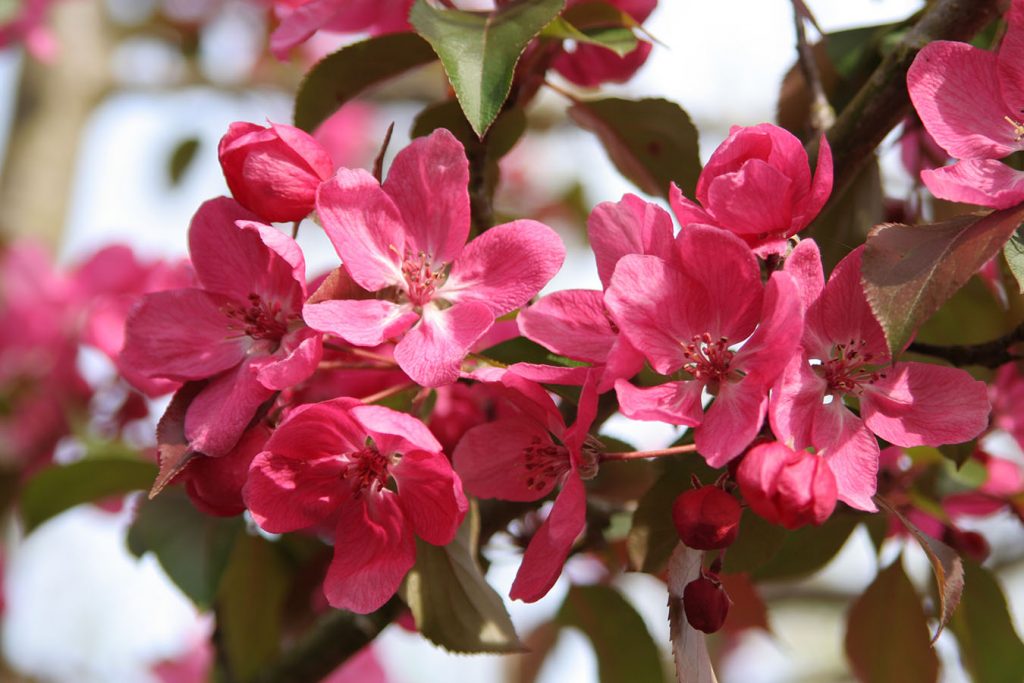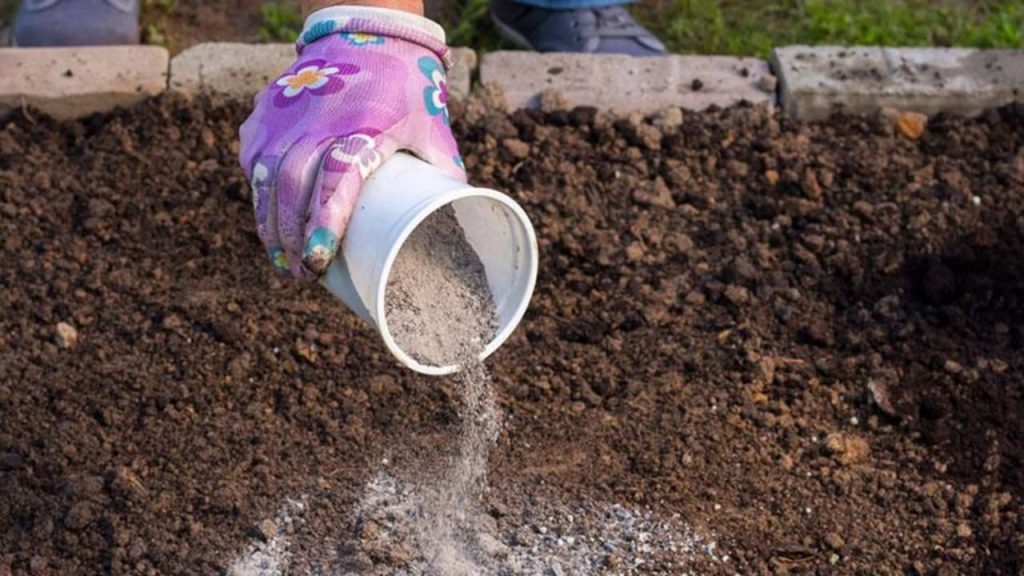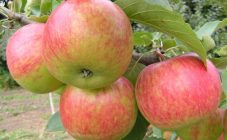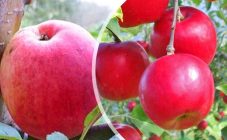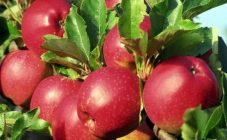Content:
Apple trees are traditionally close and familiar to us fruit trees that are easy to find, literally, on every corner. A huge selection of varieties and species allows you to choose an apple tree for every taste and color, and such a phenomenon as decorative varieties also makes it possible to decorate the garden. Apple tree Rudolph is one of these varieties. It is an amazingly beautiful hybrid variety with abundant and lush flowering that can be grown in both free and standard crops.
Main characteristics
The decorative apple tree Rudolph is an autumn vigorous hybrid that can reach 4-6 m in height. At the same time, it has a neat, pyramidal crown with rich green toothed leaves that have a reddish tint from the inside out. The crown diameter does not exceed 4 meters; when grown as a hedge, it can be formed even narrower. The variety is classified as fast-growing, since already at the age of 6-7 years the tree grows to its maximum height and practically stops the growth of shoots.
Like most apple trees, Rudolph's flowers are simple, up to 3 cm in diameter, but, thanks to the amazing splendor of flowering, he may well compete with the famous Japanese sakura. In the spring, the apple tree crown, abundantly strewn with bright pink flowers, becomes a real decoration of the garden.
In mid-September, the fruit ripens on the apple tree - ruddy, golden-orange and rather small, only 2.5 cm in diameter. Ripe fruits can remain on the tree for a very long time, retaining their decorative effect, and crumble only after the first frost (they can withstand a cold snap to -2 degrees). Such resistance to cold makes it possible to grow the Rudolph apple tree in almost any region, even in cold winters. In severe frosts, annual shoots sometimes freeze out, but they are easy to restore after spring pruning.
For all its external attractiveness, the apple of this tree has a mediocre taste - tart, astringent. Therefore, the fruits of the Rudolph apple tree are almost never consumed fresh, but they are very good in preparations: jams, compotes, for making cider or dryers.
In favorable conditions, flowering can last up to a month, much longer than other apple trees. The first fruits appear on the apple tree already in the second year of life, although their number is small. A full harvest can be harvested in 4-5 years.
Despite its decorative effect, the rudolph apple tree is distinguished by good disease resistance - it successfully resists scab and powdery mildew, from which other varieties often suffer. Nevertheless, in order to maximize the preservation of an attractive appearance, it is recommended to periodically carry out preventive treatment with appropriate preparations, especially in damp and cold years.
Growing recommendations
To decorate the garden with a decorative Rudolph apple tree, it is not enough to study the description of the variety. It is also necessary to provide the tree with proper care and growing conditions, otherwise it will be difficult to achieve the promised beauty of flowering.
First of all, it is necessary to take a responsible approach to the choice of planting material. You need to buy seedlings in proven and reliable nurseries, so the risk of getting a sick tree is significantly reduced. One thing is worth giving preference - or two-year-old seedlings, older plants take root much worse, and there is a risk that they will simply die.
The trunk of the seedling should be smooth, free from damage and growth. It is also worth paying attention to the roots - they should be slightly moist, elastic and firmly attached to the trunk. If the root comes off easily, this is evidence of putrefactive processes.
Selecting and preparing a landing site
You need to plant a tree wisely, because replanting it later, when a better place is found, will no longer be possible. Therefore, you need to immediately choose the most suitable site. The Rudolph apple tree is distinguished by its unpretentiousness to conditions, but still prefers open sunny places, well-drained fertile soil (fresh and medium loam, black soil). In the shade, the tree, of course, will grow and bear fruit, but the decorative qualities will noticeably deteriorate. Also, do not plant an apple tree where cold drafts and high humidity are frequent.
Planting dates are determined by the climatic characteristics of the region, for the middle zone it is the end of September - mid-November. You can also plant an apple tree in spring (March-early April), although it is better to do this in the fall.
Planting an apple tree Rudolph is a simple process, not much different from the usual procedure. It can be conditionally divided into three stages: pit preparation, seedling preparation and planting itself:
- A few days before disembarking, you need to prepare a pit. It is filled with a mixture of the top layer of soil, humus, peat, rotted manure, 2-3 tablespoons of potassium-phosphorus fertilizers, a handful of dolomite flour or wood ash. The pit is filled with this mixture by 2/3 and allowed to thicken;
- The size of the hole should allow the roots of the seedling to spread freely. The diameter should be about 1 m, the depth should be 0.5 m.
When the hole is ready and settled, you need to start preparing the seedling. If the roots have dried out, you can put the tree in a container with water so that they are saturated with moisture. Too long or broken off roots are best cut off immediately. Then you can start landing:
- It is necessary to install a support in the center of the pit - a long pole that will support the seedling for the first time. It should be firmly dug into the bottom of the pit and protrude about half a meter above the ground;
- Having filled the hole with soil by a third of its volume, set up a seedling, straighten the roots, tie it to a pole, and then fill the hole with the remaining soil;
- The root collar of the tree must remain above the soil surface;
- The planted tree can be shaken slightly and then compacted around it.
The distance when planting several trees depends, first of all, on their purpose. For the full development of the crown, it is necessary to provide the trees with a distance of up to 4 meters, but if the apple trees are used as a hedge, it is enough to leave only 1.5 m between them.To create an alley, a distance of 2-4 m is suitable.
Care features
In order for the hybrid apple tree Rudolph to fully reveal its capabilities, it is necessary to provide it with proper care. First of all, this is watering and regular feeding, as well as pruning and crown formation.
To facilitate maintenance and to protect against drying out of the soil, it is recommended to mulch the root circle. To do this, the soil is loosened, organic fertilizers (bird droppings, compost, manure) are added, straw, grass or other mulching material is placed on top with a layer of up to 5 cm.In such conditions, earthworms will willingly live, which will take care of loosening the soil, and much less willingly weeds will develop.
Water the apple tree regularly, but the amount of water is regulated by climatic conditions.In a dry hot summer, watering can be increased up to two times a week, 2-3 buckets at a time, and in rainy periods, it can be stopped altogether.
When using the above-described method of mulching with fertilizing at first, you can not be zealous, it will be enough to scatter a few glasses of ash around the trunk before watering. An older tree can be added to the "diet" of humus or mineral fertilizers.
Traditionally, dressing is carried out in early spring with phosphorus-potassium fertilizer. Before budding and during flowering, the tree is sprayed with copper-containing preparations, this provides protection against fungus. For the winter, the soil around the trunk is mulched with rotted manure or compost.
Annual pruning of the crown can significantly increase the decorativeness of the tree, as it increases the number of flower buds. The apple tree tolerates this procedure very easily and quickly recovers after it, therefore, it can be formed as you like, depending on the landscape design of the site or your own preferences.
Pruning is done twice a year - in spring and autumn. The first pruning is usually done in early spring, removing frozen and broken branches, as well as those that thicken the crown. It is recommended to disinfect and process the cut sites with garden varnish. At the same time, it is better to process young branches the next day, and perennial or dried ones - immediately.
In the first two years after planting on an apple tree, it is recommended to remove flowers so that it does not waste energy on fruiting, but grows more intensively. In addition, up to five years, the trunk is treated with a solution of chalk, lime is used for older trees.
For the first few years, the apple tree needs preparation for winter. It consists in hilling and mulching with manure. To protect against rodents (hares, rats, mice, etc.), the trunks are tied with spruce branches or reeds.
Advantages and disadvantages of the variety
A detailed characteristic of the variety allows you to clearly highlight both its advantages and disadvantages. The first, of course, can be attributed to the high decorativeness of the apple tree, which lasts for a very long time. Also, a plus is resistance to diseases and unfavorable climatic conditions, undemanding care. With the initial choice of the right place, the apple tree will decorate the garden for many years without excessive efforts on the part of the gardener.
The only, although not too significant, disadvantage of the Rudolph variety is the low taste of apples. However, if the purpose of growing was decorative, this is not so important. Indeed, in just a few years, the Rudolph apple tree is able to create an island of amazing beauty on the site, both in a single planting and in a tree and shrub group.

